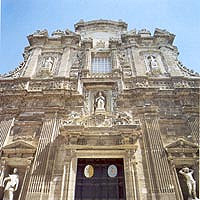
TweetThe Cathedral was started in 1629, during the baroque period. A Medieval church destroyed during early XVII Century already existed where this building was constructed. This new cathedral was dedicated to the same saint, St. Agata, and also kept the relics of other saints, among which St. Faustus' relics can still be found there.
A relic of St. Agata was kept in this Cathedral until the Basilica di Santa Caterina d’Alessandria in Galatina was completed. In 1997, the relic (a breast of St. Agata) was moved back to the Cathedral.
A beautiful 1656 painting of St. Oronzo by Giovanni Andrea Coppola surmounts the right altar.
Our Lady of the Assumption, Noah's sacrifice, and Elijah's challenge to the priests of Baal, created by Oronzo Tiso in 1757 and 1758, are as beautiful and very interesting. The 1759 wooden choir certainly is very valuable.
The Cathedral has a Latin cross layout with a nave and two aisles. These are divided by pillars with half-columns.
Twelve altars decorate the inside.
The high altar is of Neapolitan tradition. Made of bronze and marble, it is dedicated to Our Lady of the Assumption and portrays several works commissioned by Bishop Sersale. These represent “Noah's sacrifice after the Flood” and the “Sacrifice of prophet Elijah”.
The Cathedral can also be admired by a beautiful small square before the secondary façade. One of the square sides is occupied by Palazzo vescovile, built between 1420 and 1428. Palazzo Vescovile was reconstructed in 1632 and restored later.Visitors